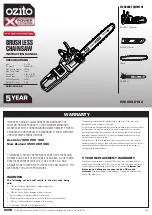
5. Starting the 41cc Petrol Chainsaw
4. Fuel and oil – Recommended fuels
Use only a mixture of unleaded petrol and special 2-stroke engine oil. Mix the fuel mixture as
indicated in the fuel mixing table.
CAUTION!
Do not use a fuel mixture which has been stored for longer than
90 days.
CAUTION!
Never use 2-stroke oil with a recommended mixing ratio of 100:1.
The manufacturer’s warranty will be voided in case of engine
damage due to inadequate lubrication.
CAUTION!
Only use containers designed and approved for the purpose to
transport and store fuel. Pour the correct quantities of petrol and
2-stroke oil into the mixing bottle provided (see scale printed on
the bottle). Then shake the bottle well.
6. Fuel mixing table
Mixing Procedure: 40 parts petrol to 1 part oil.
Petrol
2-stroke oil
1 litre
25 ml
5 litres
125 ml
3. Preparing the Petrol Chainsaw prior to use
Disengage the brake lever, then add fuel & chain oil, before starting.
Set up
Before starting the equipment
This chainsaw is supplied ready-assembled.
Check that all moving parts move smoothly
before you start using the equipment. Check that
all screws are securely fastened and also check all
the safety devices.
Before adding fuel and starting the chainsaw,
you must check the tension of the chain in case
some of the fi xings have come loose in transit.
Re-tension the chain, if this is necessary.
If it is necessary to re-tension the chain, then refer to the section ‘Adjusting the chain tension’
in the Operating Instructions manual on page 35.
Fig. 8
B
A
Fig. 9
A
C
B
WARNING!
Wear high-strength gloves at all times when handling or
adjusting the saw chain.
The correct tension of the saw chain is extremely important and
must be checked before starting and during all sawing work. If
you take time to adjust the saw chain correctly, you will be able
to make better cuts and the life of the chain will be prolonged.
The chain is correctly tensioned when it is closely seated and
can be pulled right around by hand (Fig.9/pos. A).
A new saw chain stretches, requiring adjustment after as few
as 5 cuts. This is normal with a new chain, and the interval
between future adjustments will lengthen quickly.
If the saw chain is
TOO LOOSE or TOO TAUT, the drive wheel,
chain bar, chain and crank shaft bearing will suffer premature
wear. Fig. 9/pos. A shows the correct tension (when cold) and
Fig. 9/pos. B shows the tension (when warm). Fig. 9/pos. C
shows a chain that is too loose.
Chain brake mechanical test
Your chainsaw is equipped with a Chain brake that reduces the possibility of injury due to kickback.
The brake is activated if pressure is applied against the brake lever when, as in the event of kickback,
the operator’s hand strikes the lever. When the brake is actuated, chain movement stops abruptly.
WARNING!
The purpose of the chain brake is to reduce the possibility of injury
due to kickback; however, it cannot provide the intended measure
of protection if the saw is operated carelessly. Always test the chain
brake before using your saw and periodically while on the job.
Fig. 10a
Fig. 10b
A
To test chain brake
– The Chain brake is
DISENGAGED (chain can move) when the BRAKE LEVER IS PULLED BACK AND LOCKED
(Fig. 10a).
– The chain brake is
ENGAGED (the chain is locked) when the brake lever is pulled forward and the
mechanism (Fig. 10b/pos. A) can be seen. It should not be possible to move the chain (Fig. 10b).
WARNING!
The brake lever should snap into both positions. If strong resistance
is felt,or the lever does not move into either position, do not use your
saw. Take it immediately to a professional Service Centre for repair.
1. Switch the stop switch to ‘0’ (OFF) (Fig. 12a/pos.10).
2. Pull the choke fully out until it locks (Fig. 12b/pos.17).
3. Push the primer bubble 10 times (Fig. 12c/pos.23).
4. Place the saw on a fi rm, fl at surface. Hold the saw fi rmly as shown. Pull the starter cord rapidly
2 times. (Fig. 12a/pos.7 & Fig. 12d) Beware of moving chain!
5. Push in the choke lever as far as it will go (Fig. 12b/pos.17).
6. Switch the stop switch to ‘I’ (ON) to start the machine (Fig. 12a/pos.10).
7. Hold the saw fi rmly and pull the starter rapidly 4 times. Engine should start (Fig. 12d).
CAUTION!
Never allow the starter line to snap back when it has been pulled
out. This may result in damage.
CAUTION!
Since the choke (Fig.12b/pos.17) is closed, the chain starts to move
and rotate immediately the engine is started.
8. Let the engine run for 10 seconds to warm up. Press the safety throttle lock & throttle lever briefl y,
the engine will go to ‘idling’ speed (Fig. 12e/pos.11 & pos.19).
CAUTION!
Always pull the starter cable slowly (until you feel the initial resistance)
before you then pull it quickly to start the engine. Do not allow the
starter cable to whip back of its own accord.
If the engine does not start up even after several attempts,
read the section ‘Malfunction and remedy (FAQ)’ on page 54
of the user manual.
Fig. 12a
10
7
Fig. 12e
19
11
Fig. 12b
17
Fig. 12c
23
Fig. 12d
7
Starter line / starter cable.
10
ON/OFF (stop) switch.
11
Safety Throttle lock.
17
Choke.
19
Throttle lever.
23
Fuel pump 'primer bubble'.
Fig. 7
64055_4501826_11025_qsg.indd 2
17/11/2015 12:57 p.m.




















